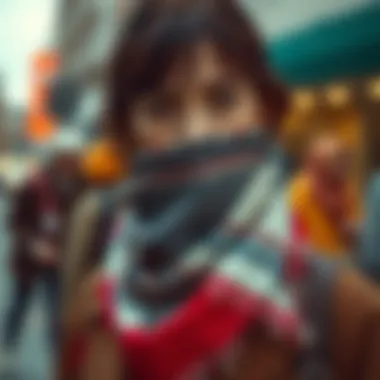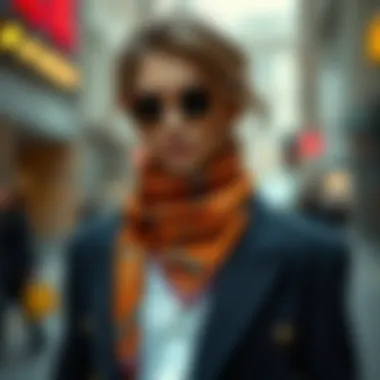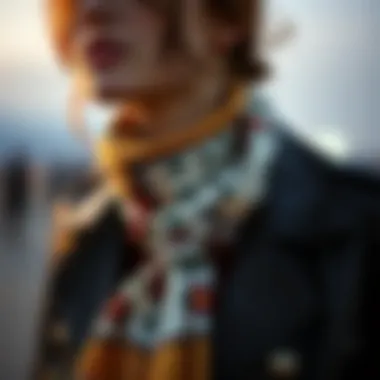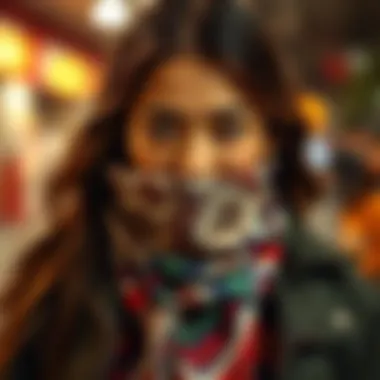The 70s Scarf: A Timeless Fashion Statement


Intro
The 70s got a bad rep for many things—be it the outrageous bell-bottoms or the questionable hairstyles. Yet, one accessory from that vibrant era has weathered the test of time: the scarf. More than just a piece of fabric, this versatile item played a key role in personal expression, social movements, and transcended mere fashion trends. With its roots digging deep into various cultures, the 70s scarf tells a tale of individuality amidst communal vibes.
From chic ensembles worn by fashion icons to everyday street style, the scarf morphs into countless forms, adapting effortlessly to changing tastes and trends. It weaves together not only the fabric of personal style but also the rich history of a decade that pushed boundaries in more ways than one. Let’s take a closer look at this understated yet bold accessory that remains relevant even today.
Latest Trends in Clothing
Seasonal Must-Haves
The scarf isn't just a relic of the past; it enjoys a continual revival across fashion seasons. Currently, trendy styles incorporate vibrant colors and eclectic prints—think paisleys, florals, and geometric patterns reminiscent of the 70s. Scarf options range from silk twill for a touch of luxury to cotton for a laid-back vibe. It’s not just about keeping warm anymore; it’s about making a statement.
When the temperatures start to dip, consider layering a scarf over a chunky knit sweater or a leather jacket. As the weather warms up, a lightweight scarf tied around the neck can elevate even the simplest of outfits.
- Bright Colors: The resurgence of bold, eye-catching colors reflects the spirit of the 70s. Look for jewel tones that pop.
- Textured Fabrics: From velvet to crochet, tactile materials add depth and interest to your outfit.
- Oversized Styles: Large, draping scarves not only provide warmth but also create dramatic silhouettes, drawing the eye.
Influential Fashion Icons
Who better to look to for scarf inspiration than the icons of the 70s themselves? Names like Jimi Hendrix, Janis Joplin, and Bianca Jagger are etched into the fashion halls of fame, showcasing how a simple scarf can transform an outfit into something timeless and rebellious.
- Jimi Hendrix was known for his flamboyant style, often pairing scarves with his psychedelic prints.
- Janis Joplin would wear scarves in her hair, channeling a free-spirited vibe that resonated with countless fans.
- Bianca Jagger made headlines by gracing her wedding festivities in a fantastical scarf that accentuated her sleek dress, solidifying its status as a statement piece.
It’s not just about what they wore but how they wore it—seemingly effortless yet incredibly bold. The lesson is simple: don’t shy away from wrapping, tying, or layering a scarf your own way.
"The beauty of the scarf lies in its ability to convey significant personal style with such simple strokes."
With these influential figures paving the way, contemporary fashion lovers harness similar elements of creativity to make the scarf their own. The woven fabric blends history with modernity—a true testament to the enduring allure of this timeless accessory.
Practical Dressing Tips
Wardrobe Essentials
To weave the scarf seamlessly into your wardrobe, consider these essential pointers.
- Invest in a Basic Scarf: Start with something neutral, like a classic black or beige. It can ground any outfit.
- Experiment with Lengths: From long, flowing pieces to short and snug variations, having a bit of variety will enhance your styling options.
- Stash Different Fabrics: Whether it’s silk for elegance or cotton for casual days, having a range of materials can help adapt to various settings.
Style Guides for Different Occasions
Navigating different occasions with a scarf can be straightforward if you keep a few guidelines in mind:
- Casual Outings: Drape a lightweight scarf over a simple tee and jeans for that effortless chic look.
- Formal Events: Opt for a silk scarf tied elegantly around your neck or as a headband, adding a touch of sophistication.
- Bohemian Gatherings: Channel your inner hippie with a colorful scarf wrapped around your waist as a belt or in your hair, infusing your ensemble with a whimsical edge.
In the end, the 70s scarf is not just a piece of fabric; it’s a canvas for self-expression and identity, evolving in its purpose and adapting to each generation's style benchmarks.
Understanding the 70s Scarf
The 1970s marked a significant shift in the fashion landscape, and the scarf emerged as an essential accessory during this transformative decade. Understanding the 70s scarf isn’t just about recognizing its aesthetic appeal; it encompasses a broader understanding of its cultural context and enduring relevance in fashion history. This article aims to explore this iconic accessory, dissecting its various influences and the significance it holds even today.
Historical Background
In the backdrop of the 70s, the world was undergoing profound changes—social movements, musical revolutions, and the rise of counterculture profoundly influenced fashion. Scarves, which previously functioned largely as utilitarian items, morphed into statements of style and personal expression. Designers like Halston and Diane Von Furstenberg incorporated scarves into their collections, showcasing their versatility.
The scarf not only adorned necks but also became a symbol of liberation and freedom, often sported by icons in the vibrant music scene of that era. It's said that a beautifully styled scarf could take a mundane outfit, perhaps a jeans-and-tee combo, and elevate it into something extraordinary—and the ability to do so quickly became part of its charm.
Cultural Significance
The cultural significance of the 70s scarf reaches far beyond mere fabric. It became an emblem of individuality at a time when self-expression was paramount. Many used scarves to represent causes—be it peace, freedom, or the feminist movement. When worn by figures like Janis Joplin, the scarf transformed into a marker of the times, melding fashion with activism.
"The scarf wasn't just an accessory; it was a voice. It told stories without uttering a single word."


Scarves encouraged personal flair in the era’s more homogenized fashion offerings, allowing individuals to define their style. The accessory was a canvas, showcasing bold designs and patterns, harmonizing with the decade's psychedelic influences. As a result, the scarf held a dual role—both a fashionable add-on and a cultural artifact.
Evolution Through Decades
The evolution of the scarf can be visualized as a tapestry of trends that cross various fashion eras. While the 70s marked a peak in its popularity, this vibrant accessory did not vanish into the shadows after the decade closed its curtains.
Through the 80s and 90s, the scarf retained its status but adjusted to the shifting fashion norms. Designers like Yves Saint Laurent brought fresh interpretations that aligned with the more structured silhouettes of those decades. Fast forward to today, and the scarf is experiencing yet another renaissance, blending the retro 70s vibe with modern sensibilities.
It now serves not only as a nostalgic nod but also as a versatile staple that continues to be embraced by fashion enthusiasts across generations. The 70s scarf, therefore, is not simply a product of its time; it represents a legacy that continues to evolve, adapt, and inspire.
This exploration sets the stage for a deeper dive into Materials and Textures, where we will uncover the tangible elements that make the 70s scarf such a cherished accessory.
Materials and Textures
The world of fashion is often shaped by the materials and textures that make up its garments. When considering the 70s scarf, these aspects become especially crucial. The right fabric not only defines the scarf’s aesthetic but also influences its functionality. Materials can vary widely, impacting everything from the scarf’s drape to the way it interacts with colors and prints.
Fabric Choices
In the era of the 1970s, a plethora of fabrics was used in creating scarves, each bringing its own flair and personality. Common choices included:
- Silk: Known for its luxurious feel and shiny appearance, silk scarves were the epitome of elegance. They added a touch of sophistication and were often adorned with intricate patterns, making them a favorite among fashion icons.
- Cotton: Lightweight and breathable, cotton scarves offered versatility and comfort. They were ideal for casual wear and could be found in a myriad of prints, often reflecting the vibrant, earthy hues popular in the 70s.
- Polyester: Affordable and durable, polyester scarves became widely popular. They offered a range of colors and patterns, appealing to a broader audience. Their ability to hold shapes well made them desirable for various styling techniques.
The choice of fabric significantly impacts how the scarf falls, wraps, and can be styled. For instance, a silk scarf can gracefully drape, while a cotton version might provide a more structured look.
Texture and Its Impact
Texture is another vital element that imparts character to a scarf. Different textures can evoke various feelings and styles, adding depth to even the simplest of outfits. The textured fabric can set the tone of the entire look, enhancing both casual and formal styles.
The impact of texture becomes apparent when considering these common finishes:
- Smooth: Conveys sophistication and elegance. Smooth textures, typical of silk and satin scarves, often highlight detailed prints, making them an ideal choice for dressy occasions.
- Nubby or Wrinkled: Fabrics like linen can offer a relaxed, bohemian feel, perfect for the free-spirited style that dominated the 70s. This kind of texture often aligns with earthy tones and playful prints, reflecting a laid-back attitude.
- Patterned: A subtly textured fabric paired with vibrant patterns can create a stunning visual impact. The tactile quality not only attracts attention but also invites touch, enhancing the overall sensory experience of fashion.
"The texture of a scarf is not just what you see, but what you feel; it adds a personal touch to the intimate style journey."
Design Variations
When it comes to the 70s scarf, the term "design variations" encapsulates more than just changing patterns or colors. This section emphasizes how these variations play a pivotal role in the accessory's enduring relevance. The styles vary widely, owing to influences from cultural movements, trends, and individual creativity. Each design variation tells a unique story, offering people a means of personal expression, all while remaining tied to a rich historical context.
Patterns and Prints
Patterns and prints on 70s scarves are often bold and eclectic, reflecting the vibrancy of the decade itself. Floral patterns, paisley designs, and geometric shapes frequently dominated the landscape. Combinations of contrasting colors made these scarves real statement pieces. For instance, a brightly patterned scarf could take a simple outfit and transform it into something eye-catching and stylish. The choice of print often communicates the wearer’s personality and style, whether it be bohemian, chic, or daringly avant-garde.
In particular, paisley made a notable comeback in the 70s, drawing from its historical roots while revitalizing fashion aesthetics in a modern light. These prints weren't just popular for their look; they also carried a cultural weight, often linking back to the counterculture movements that emphasized freedom and creativity.
Color Schemes of the 70s
The vibrant color palettes of the 70s are strikingly memorable. Earth tones reigned supreme; think warm browns, deep oranges, and olive greens. These colors often evoke a sense of nostalgia, taking us back to a time when natural and organic forms heavily influenced style choices. Bright splashes of color, like hot pink or electric blue, would make an appearance as well, serving as accents in patterns or boldly in stripes on scarves.
Layering a scarf in these hues over a denim jacket turns an ordinary outfit into one that embraces the spirit of the era.
Iconic Styles
Specific scarf styles emerged during the 70s, sealing their status as icons in the fashion world. The bandana-style scarf, often tied loosely around the neck, quickly gained popularity among both men and women, reflecting a laid-back yet rebellious attitude. The oversized square scarf, usually made of silk, became a chic accessory that could be styled in numerous ways—from headwraps to belt embellishments. Moreover, the use of scarves in hair fashion reached new heights. Worn as headbands or in place of traditional hairstyles, these stylish knots adorned many heads, making them a quintessential symbol of the 70s aesthetic.
"Scarves during the 70s weren't just fashion statements; they embodied the spirit of an era defined by rebellion, freedom, and an embrace of the individual style."
In summary, the design variations in 70s scarves were diverse and impactful. They served not only to enhance the wearer’s appearance but also to express deeper cultural sentiments that resonated with the time. By embracing these intricate patterns, vivid color schemes, and iconic styles, wearers could carve out their own niche within the rich tapestry of 70s fashion.
Styling the 70s Scarf
The 70s scarf transcends being a mere accessory; it’s a canvas for personal expression and a reflection of one's style ethos. In this era when fashion was all about making statements, the way one styled a scarf spoke volumes about their identity and influences. From classic knotting techniques to innovative uses, the 70s scarf has been versatile enough to fit numerous roles in a wardrobe. Understanding how to drape, tie, and incorporate this accessory into various ensembles is paramount in celebrating its legacy.
Classic Knot Techniques


When it comes to classic knotting, the 70s scarf offers a plethora of options to elevate any outfit. The simple yet effective way of tying the scarf around the neck in a loose knot not only keeps one warm but also introduces a laid-back flair. This technique echoes the relaxed style of the decade.
Another popular method is the loop knot. This involves folding the scarf in half and pulling the ends through the loop, creating a snug and stylish accent. It captures the essence of bohemian spirit, which was vibrant during the 70s. Yet another simple technique is the basic twist. By twisting the scarf and draping it around the neck, it instantly adds texture and visual interest to any outfit.
Each of these knotting styles serves a functional and aesthetic purpose, allowing wearers to showcase their creativity while staying fashionable.
Innovative Uses
As the 70s evolved, so did the creative applications of the scarf. Beyond its conventional uses, savvy fashion enthusiasts started to experiment. One striking innovation was using the scarf as a hair accessory. Whether worn as a headband or tied around a ponytail, it not only kept hair in place but also added a dash of chic to the look. This practice drew upon the era's freedom of expression.
Moreover, scarves began to find their way onto bags. By tying a scarf around the handle of a tote or handbag, it infused a splash of color and personality into an otherwise plain accessory. Making a belt out of a scarf offered another unique way to combine function with fashion, cinching together pieces to create new silhouettes and enhance shapes.
Layering with Other Garments
Layering is an art, and the scarf plays a significant role in mastering it. Imagine a lightweight scarf draped over a fitted leather jacket or a flowy blouse. This layering technique complements various textures and fabrics, crafting a visual feast that reflects sophistication.
Pairing a scarf with a chunky knit sweater brings an appealing contrast; it softens the heaviness of the knit while adding dimension. Additionally, tying a scarf over a sleek dress introduces an unexpected twist, turning an evening outfit into a versatile day-to-night piece. Mixing various patterns, such as a floral dress with a striped scarf, creates a delightful interplay that embodies the eclectic style of the 70s.
"The way a scarf can transform an outfit is akin to a stroke of artistry upon a canvas."
In essence, styling the 70s scarf is not just about tradition; it’s about pushing boundaries and exploring personal style realms. Each knot and use serves to connote a deeper narrative, drawing from the rich tapestry of the decade's cultural and sartorial benchmarks.
The Scarf in Contemporary Fashion
In today’s fashion landscape, the 70s scarf holds a unique position, bridging the gap between nostalgia and modernity. It’s a testament to how a simple piece of fabric can spark creativity and redefine individual style. With its ability to adapt to contemporary trends while retaining its vintage charm, the scarf has become an essential accessory in both casual and haute couture settings.
Revival of the 70s Trend
The revival of the 70s trend can be largely attributed to the cyclical nature of fashion. Designers and consumers alike have shown a fascination with the bold prints, vibrant colors, and imaginative styles that characterized that decade. Scarves made their mark in many different ways during the 70s, from being used as headbands by fashion icons like Grace Jones to playful neck accessories in bohemian outfits.
Today, wearing a scarf that reflects this era is akin to donning a piece of art. Influencers and fashion enthusiasts often showcase their unique spins on the styles, bringing back that carefree spirit. Whether it’s a silk scarf tied to a handbag or a larger piece draped over a blouse, these accessories provide a nostalgic nod while being thoroughly modern.
As consumers explore personal expression through fashion, the revival of the 70s scarf allows for experimentation and individuality. Mixing prints, layering with other accessories, or simply tying it in a manner that is distinctly one’s own plays into this adaptability. Moreover, fashion houses are taking cues from the past but with a contemporary twist, and this has ignited a fresh interest in vintage scarves.
Influence on Modern Designers
The influence of the 70s scarf on modern designers can hardly be overstated. Renowned fashion houses such as Gucci and Prada have drawn inspiration from that decade, reimagining classic scarf patterns and textures in innovative ways. The emergence of sustainable fashion has also encouraged a focus on timeless pieces, allowing designers to emphasize the durability and diversity of scarves.
This resurgence can be seen in collections where scarves are integrated into the overall aesthetic rather than just being an accessory. Designers like Isabel Marant and Etro have successfully blended the colorful motifs of the 70s with modern silhouettes, creating what can only be described as a harmonious marriage between eras.
In addition, the role of social media cannot be ignored. Platforms like Instagram and TikTok have democratized fashion, allowing individuals and lesser-known designers to showcase their takes on the 70s scarf. This has fostered a community of collectors and enthusiasts, eager to share styling tips ranging from the classic to the avant-garde. As a result, the modern landscape of scarves reflects a collaboration of past and present, making it an ever-evolving canvas for creativity.
The 70s scarf proves that what was once old can always be new again, continually inspiring generations to express themselves through style.
Sustainability in Scarf Production
The conversation surrounding fashion today extends much further than mere aesthetics; it incorporates the ethical and environmental ramifications of what we wear. The sustainability in scarf production is a crucial topic that deserves a close look. This exploration not only sheds light on the methods used to create these timeless accessories but also emphasizes the responsibilities of both consumers and producers in fostering a more accountable industry. It dives into the overlooked aspects of material sourcing, the effects of fast fashion, and how mindful practices can ensure that scarves remain as beloved in future decades as they were in the 70s.
Ethical Sourcing of Materials
The very fabric of sustainability lies in the sourcing of materials used to create scarves. Ethical sourcing involves the procurement of raw materials in a manner that respects both environmental guidelines and labor rights. Notably, brands that prioritize organic cotton or sustainable fibers such as bamboo or hemp not only reduce their carbon footprint but also offer consumers a clear conscience with each purchase.
When looking at ethical sourcing, consider:
- Organic Materials: Scarves made from organic cotton negate the use of harmful pesticides and synthetic fertilizers, promoting healthier agricultural practices.
- Recycled Fabrics: Some producers are tapping into post-consumer waste by transforming plastic bottles or discarded textiles into fashionable scarves, addressing waste management issues effectively.
- Fair Trade Practices: Brands that engage in fair trade ensure that their workers receive fair wages and work in safe conditions, pushing back against exploitative labor practices prevalent in the industry.
The challenge lies in identifying which brands genuinely commit to ethical sourcing, as greenwashing can often obscure the reality behind their marketing campaigns. Ultimately, the burden also rests on consumers to demand transparency and hold brands accountable.
Impact of Fast Fashion


Fast fashion has cast a long shadow over the fashion world, producing garments at alarming rates, contributing to waste, and fostering a fleeting relationship between consumers and their clothes. Scarves, once cherished for their timeless elegance, have been caught in this whirlwind, leading to a cycle of excessive production and disposal. The impact of fast fashion on scarf production manifests in various ways:
- Increased Waste: The rapid turnover of styles has resulted in mountains of discarded textiles, many of which end up in landfills.
- Environmental Degradation: The production processes often involve water-intensive methods and detrimental chemical use, causing environmental harm.
- Cultural Dilution: The unique flair that scarves from the 70s brought has been diluted in the frenzy of mass production, leading to a loss of individuality and cultural significance.
According to a report from the Ellen MacArthur Foundation, the fashion industry generates around 92 million tonnes of waste each year, with scarves and accessories contributing a noteworthy portion to that figure. This insight serves as a clarion call for both consumers and creators to step away from a culture of disposability and embrace timeless pieces crafted with intention.
Personal Expression Through Scarves
The way one adorns oneself speaks volumes. When it comes to scarves, especially those that reflect the distinct style of the 1970s, they serve as more than just a piece of fabric around the neck—they become a canvas for personal expression. Various styles and colors of scarves allow individuals to craft an identity that resonates with their unique taste and personality. Through this accessory, people can show off their creative side or even convey a deeper message about their values or aspirations. Scarves have the ability to adapt to every mood, every outfit, and even every season, providing versatility rarely matched by other accessories.
Creating Individual Style
Crafting individuality with a scarf often begins with choice. The material, pattern, and knotting technique can transform a simple look into something extraordinary. For instance, a bright floral scarf tied casually around the neck can add a playful flair to an otherwise monochromatic outfit, while a silk scarf featuring geometric patterns can evoke sophistication and elegance. It’s worth noting how the choice of fabric influences not only the style but also the comfort and appropriateness for the occasion.
But it’s not just the scarf alone that dictates style—how it’s worn matters too. Take the classic fold-and-tuck method; this seemingly simple technique can produce varying results depending on the style of the scarf. Just think about the effect of wearing a wide scarf draped over the shoulders versus a long, slim scarf artfully knotted. This variety gives the wearer a chance to experiment and express their unique style time and again.
Another aspect to consider is how scarves can anchor a look or even act as a signature piece that represents one's aesthetic. Maybe you’ve seen a fashionista wrap a bold, patterned scarf as a headband; this not only adds colour but also serves as a talking point. The individuality expressed through this seemingly small item can spark interactions with like-minded individuals or simply provide a boost of confidence in one’s style choices.
Cultural Identity and Fashion
Scarves do not only serve a personal connection; they often celebrate cultural identity as well. In the 1970s, scarves played a significant role in various social movements, becoming symbols of resistance or cultural pride for many different communities. Their presence in fashion was interwoven with political messages or cultural references, making them a vehicle for personal and collective beliefs. People might choose a scarf patterned with cultural motifs as a way to honor their heritage or communicate their views on modern society.
Moreover, the act of wearing a specific kind of scarf can evoke a sense of belonging, especially in multicultural urban settings where diversity thrives. For instance, a vintage bandana might carry different connotations for someone who associates it with rock music as opposed to someone who views it as a nod to farm heritage. Each scarf tells a story, linking the individual to larger narratives of tradition, community, and identity.
In the end, whether worn to assert individuality or signify cultural roots, scarves enrich the narrative surrounding personal expression. They are versatile, artistic tools in the realm of fashion, reflecting the wearer’s spirit.
"The beauty of a scarf lies in its simplicity; yet within that simplicity, a world of stories and identities unfolds."
For further exploration into personal styles and how they’ve evolved over the years, consider visiting Wikipedia for historical insights or Britannica for a broader cultural context.
Maintaining and Caring for Scarves
Scarves, particularly those from the vibrant 70s era, are not just accessories; they are cherished pieces of fabric history. Just like any valuable item, maintaining and caring for scarves is crucial to ensure their longevity and beauty. A well-kept scarf can enhance a wardrobe for decades, but neglecting it can lead to those once-bright hues fading and textures becoming rough.
Cleaning Techniques
Cleaning a scarf may seem straightforward, but the method you choose greatly depends on its fabric composition. Here’s a concise guide:
- Read the Label: Always start by checking the care label. This will inform you of the right cleaning approach.
- Hand Wash vs. Machine Wash:
- Spot Cleaning: If there's a specific stain, dab it with a mixture of cold water and mild soap. Avoid scrubbing, as this can damage the fibers.
- Drying: After washing, lay the scarf flat on a towel to absorb excess water and reshape it. Avoid wringing out, as this can distort its shape.
- For silk, linen, and delicate fabrics, hand washing is preferable. Use cool water and a mild detergent, and gently agitate to remove dirt.
- For sturdier materials like cotton, machine washing on a gentle cycle is acceptable. Consider placing the scarf in a mesh bag to prevent tangling.
"A little care goes a long way in preserving the charm of your 70s scarf!"
Storage Solutions
Bad storage practices can lead to creases and loss of form, which can be quite a shame for an item with such historical value. Here are some effective storage solutions to consider:
- Hanging: For scarves that resist wrinkling, hanging them on a dedicated rack or using clips ensures they remain untangled and wrinkle-free.
- Rolling Up: For delicate fabrics, rolling each scarf can prevent creasing. This method is also space-efficient.
- Drawer Organization: Use dividers to keep scarves organized within a drawer. This technique prevents them from getting crumpled or entangled with other garments.
- Avoiding Light Exposure: Store your scarves away from direct sunlight to prevent fading and maintain their vivid colors over time.
Epilogue
In summarizing the role of the 70s scarf within the larger cultural and fashion narrative, one cannot overlook its impressive versatility and constant reinvention. This article has traversed various facets, shedding light on how this accessory is more than just fabric draped about one’s neck—it's a symbol of identity, expression, and evolution.
The Timeless Allure of the 70s Scarf
The appeal of the 70s scarf lies in its rich history and cultural roots. It became a canvas for creativity, encapsulating the vibrancy of the decade while also adapting to contemporary tastes. Each scarf tells a story; from the bohemian lifestyles of the 70s to its resurgence in today's fashion landscape, it mirrors societal trends and personal styles.
The 70s scarf represents a unique intersection where tradition meets modernity. Here are key reasons why it remains relevant:
- Cultural Symbolism: Beyond aesthetics, the scarf carries historical significances, linking past movements to current fashion statements.
- Expression of Individuality: Whether worn as a headpiece, tied to a handbag, or simply wrapped around the neck, it allows for personal flair, helping individuals to assert their uniqueness.
- Fashion Flexibility: From complementing casual outfits to elevating formal wear, it is a chameleon, adapting seamlessly to various occasions.
"Scarves are the unsung heroes of fashion, transforming the mundane into the extraordinary with every style choice."
It's imperative for fashion lovers and industry professionals alike to recognize how the scarf can redefine an ensemble. Its ability to breathe new life into simple outfits, coupled with the nostalgia it evokes, underscores its timeless allure. As we conclude this exploration, consider not just the scarf's role as an accessory, but also as a profound statement of self-expression that continues to foster creative possibilities in wardrobes today.







